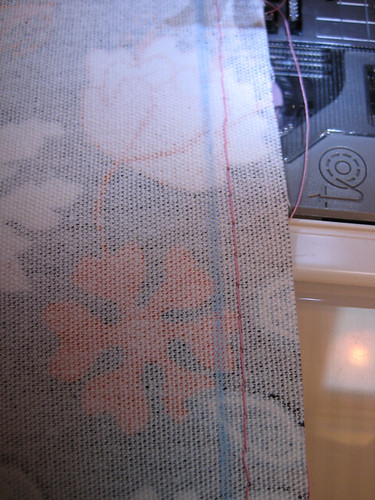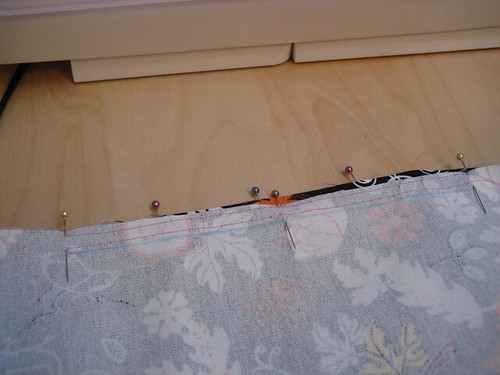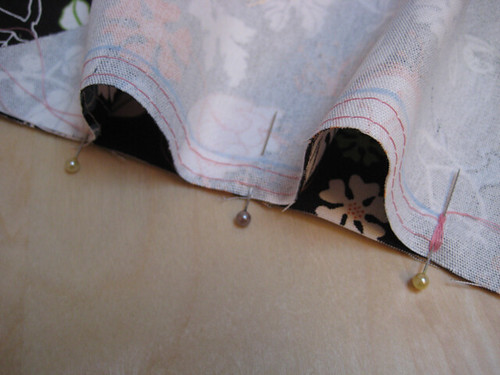Last week someone left a comment here looking for advice on making the gathers for the Lisette bag. This gave me the idea to talk about the method I use for gathering, as it could be useful to others.
I discovered this method to prepare gathers by machine instead of doing it all by hand last year in my sewing book. I’ve been using it ever since, because it saves time and, in my case, it makes more regular gathers. It uses regular thread in place of basting thread, which is good for thick fabric because your thread won’t break as easily. It’s not as easy to remove the gathering threads afterwards, but sometimes you don’t have to. I left them in place on the Lisette bag since they’re hidden inside. For this tutorial I used a remnant of my bag’s fabric.
How to make gathers
* choose the straight stitch on your sewing machine and set the stitch length to the maximum length
* set the thread tension to zero
* stitch a first straight line along the part that will be gathered
* stitch a second line approx. 6mm away from the first. Be as regular as you can so that the stitches match.
On the Lisette bag I stitched both lines inside the sewing allowance so that I didn’t have to remove the threads. On the pictures the sewing line is in blue.
* to pin the gathered fabric to the fabric it will be attached to, I start by marking different corresponding points on each fabric (middle of the gathered section, quarter, …).
* then I match them before pining. This will help spread your gathers evenly. The pins are perpendicular to the stitching line.
* the gathers are made using only the top threads. Those at the back of the fabric are left alone. First you have to block one end of the threads, by rolling them around a pin. You then pull the threads at the other end to create gathers. Move them to the other end as you go. Go slowly and do not pull too hard, especially with thick fabrics. If it seems the thread won’t go further, stop pulling and move the gathers towards the other end before you start pulling again. Here is a little video I made to show what I’m talking about:
* when the gathers are looking good and the two fabrics are aligned, add some pins so that the top fabric can’t move. All you have to do now is stitch on the sewing line. Do not forget to set the stitch length and thread tension back to their usual values first!
I’d be happy to know what you think of this tutorial, so do not hesitate to leave a comment.
Of course there are other ways to make gathers. The classic way, that my mother taught me, is to prepare them by hand with a basting thread and then sew between the two gathering lines. You can also get a gathering foot for your sewing machine. Those gather and stitch all in one step. I have one but I haven’t really used it yet. Maybe I’ll write about those in a future post if I get used to it. ^_^






très bien ton tuto, je fais à peu près la même chose. Après avoir fais mes fronces à la main (c’est loooong), je les fait à la machine, je n’ai par contre jamais essayé de mettre les épingles pour mieux repartir les fronces. ça ne gêne pas le fronçage? je vais tester dès que possible, merci
Merci ! ^_^Non ça ne gêne pas le fronçage, il n’y en a pas beaucoup au départ et les fronces se “déplacent” bien de l’autre côté des aiguilles quand on pousse le tissu. Quant à celles que je mets au fur et à mesure pour fixer, c’est une fois qu’elles sont réparties donc ça ne bouge plus.
Quelles belles fronces! Les miennes ne sont jamais aussi bien soignées!
Merci ! Les miennes ne l’étaient pas non plus jusqu’à ce que j’adopte cette technique de piquer à la machine. Et j’y vais ensuite patiemment pour bien répartir également en fixant avec les épingles au fur et à mesure. Ca n’est toujours pas un plaisir mais c’est quand même moins long qu’à la main et le résultat vaut le coup !